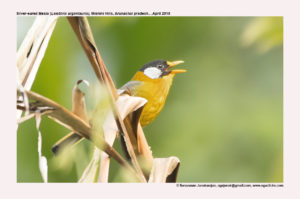
Silver-eared Mesia Mesia argentauris
Etymology:
- Mesia : Nepali name
- Argentauris : Latin word argentum – silver; auris – ear. { Silver Eared }
Vernacular Names: Pahari: Jharjhari, Lepcha: Dang-rapchil-pho
Distribution in India: Resident of Himalayas and hills of North East India.
Description: Size of 15·5–17 cm; wt. of 22–29 g. It is a smallish babbler in bright, neat colours, black on head with glistening silver ear-coverts, yellow breast, and red wing patch and tail base. The male of nominate race has clear-cut jet-black crown to lores, fore cheek and upper submoustachial area, with orange-yellow patch on forehead above bill base, broadly fanned glistening silvery ear-coverts, dull orange-grey nuchal collar joining with bright yellow-orange chin to breast, and shading to grey on upperparts. The upperwing has reddish patch at base of flight-feathers, latter fringed orange-yellow; black tail with narrow yellow margins on outer webs, orange-reddish uppertail-coverts. It has duller yellowish-olive lower underparts; iris is brown to crimson; bill is orange-yellow; legs are yellowish-flesh. The female has duller, paler forehead patch, throat and breast, dull golden-olive nuchal collar and uppertail-coverts, less yellow central underparts, pale yellowish-rufous undertail-coverts, paler and duller reddish wing patch and yellow wing fringing. The juvenile is like respective adult, but black of head duller, rest of body colours more washed out.
Habitat: It is found in bushes, undergrowth, lower and middle storeys in more open broadleaf evergreen, pine and mixed forests, forest edge, secondary growth, scrub, abandoned cultivation, tea plantations, bamboo, sometimes other grassland. It is found from 175–2600 m.
Food habits: it eats insects and their larvae, ants, berries, fruits and seeds. After breeding season it forms parties associating with bird waves includes other babblers. It keeps to bushes in more open forest, sometimes ascends quite high in canopy. It makes flycatching sallies after escaping insects.
Breeding habits: They breed in Nov–Aug in India and Apr- Aug in Bhutan. The nest is built by both sexes over 4 days. The nest is a deep, substantial cup made of dead bamboo or other leaves, grass, moss, bracken and roots, lined with rootlets or fern/palm fibres, placed from just above ground in bush, slung from fine stems of small vines among branches of bushes or in bracken. They lay a clutch of 2–5 eggs. The incubation is done by both parents starting from first egg. The incubation period is 13–14 days. The nestlings are provisioned by both parents. The nestling period is 12 days. The post-fledging dependence is 22 days.